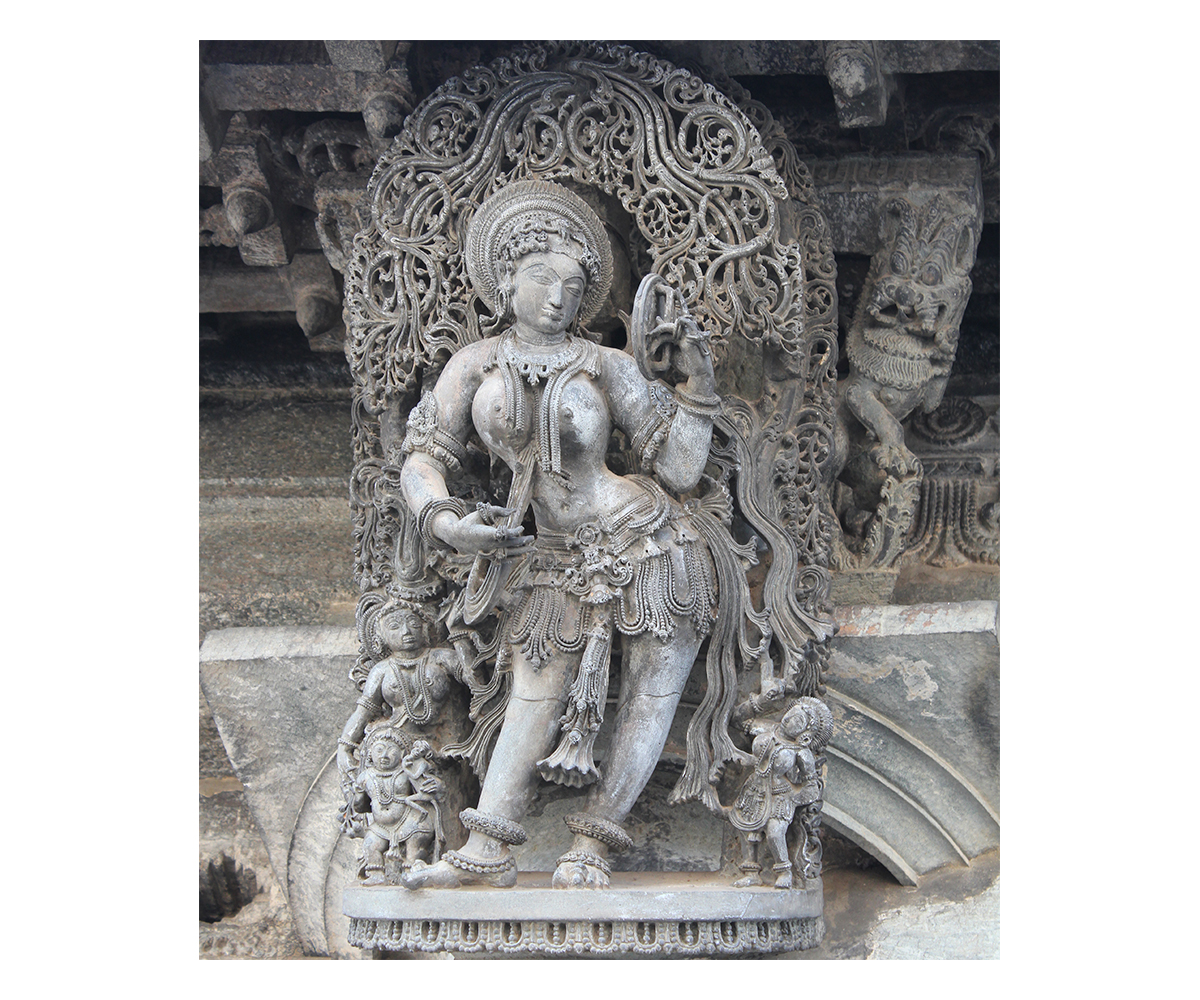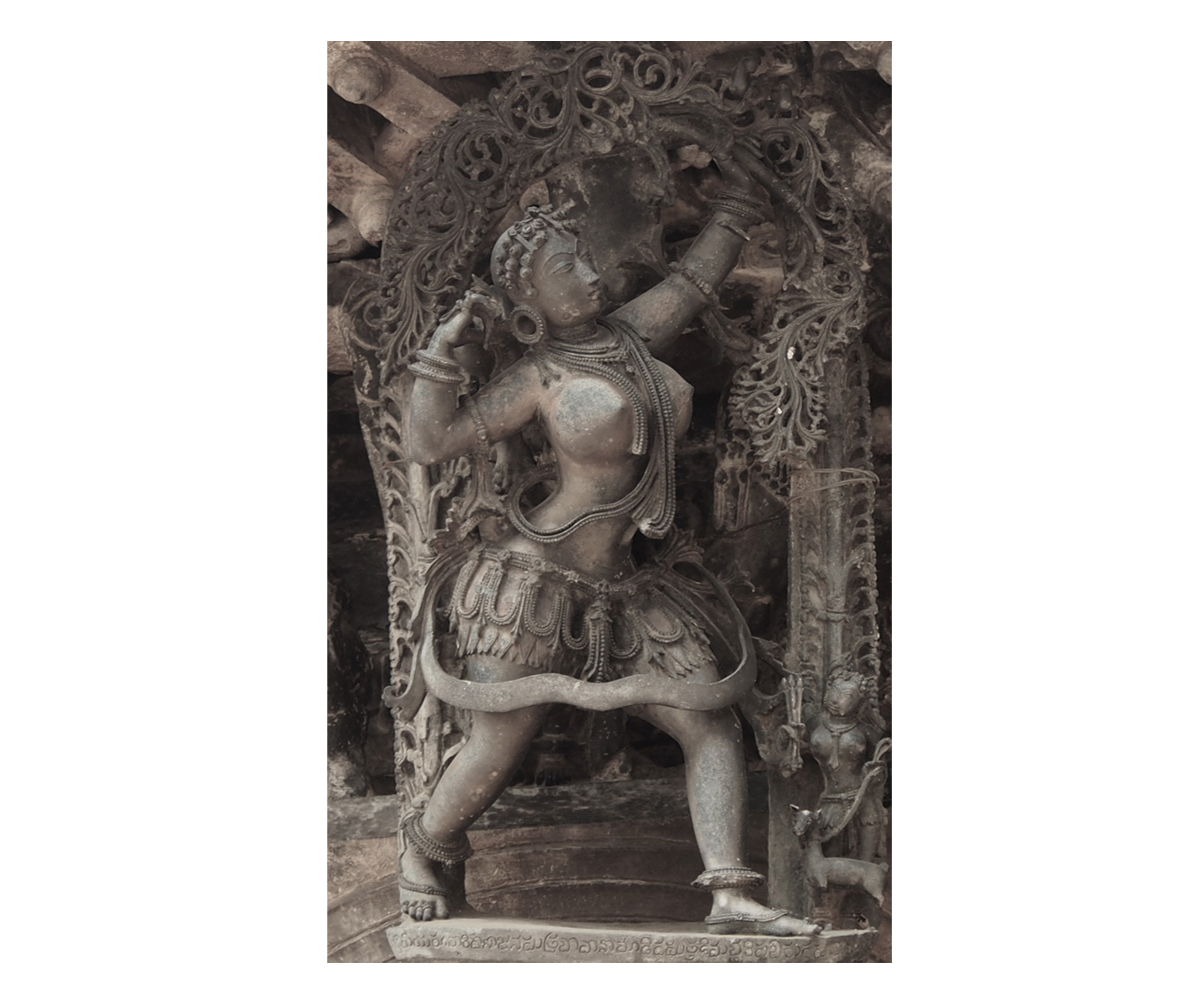ARTICLE
Chavana
Active in the early twelfth century, Chavana was a master sculptor working for the Hoysala court. With his father, the master sculptor Dasoja, Chavana is known for his work on the decorative bracket figures or madanikas at the Chennakeshava temple, Belur in Karnataka, India.
Chavana hailed from the village of Balligrama (also known as Balligamve, now Balligave, in Shivamogga district, Karnataka), which he references in an inscription where he calls himself a ‘bee at the lotus feet of the god Dharmeshvara of Balligamve’. Balligrama was an important cultural centre in the Western Chalukya kingdom, alongside others such as Lokkigundi, Gadaga and Banavase. In the early twelfth century when temple-building began to be patronised extensively by royal and non-royal figures in the Hoysala kingdom, artists from these centres began migrating to centres such as Belur and Halebeedu to participate in projects like the Chennakeshava temple, Belur and the Hoysaleshvara temple, Halebeedu. Chavana and Dasoja are among several master craftspersons, including Ruvari Mallithamma, who travelled significant distances across the Hoysala kingdom in present-day Karnataka, contributing their expertise and knowledge to the art and architecture of the temples of the period.
There is little information about Chavana apart from his work at the Chennakeshava temple, Belur, where he is thought to have worked for around five years with his father Dasoja before moving to a different site. Here, Chavana contributed four madanika images in the exterior and interior sections of the mandapa, including sculptures of a huntress and a dancer.
Like his father, Chavana was known by different epithets, including Macheharipa birudaruvari Madana Mahesa (‘Shiva to the Cupid of titled sculptors’) and Macheharipa birudaruvari sarabhabherunda (‘Bherunda to the Sarabha of rival sculptors’), likely referring to gandabherunda and the sharabha, mythical beasts in Hindu mythology associated with Vishnu and Shiva, respectively.
There is no available information about Chavana’s work after 1117.
Bibliography
Bose, Kamalika, and George Michell. The Hoysala Legacy: Belur, Halebidu, Somanathapura. Mumbai: Jaico Publishing House, 2019.
Karnataka Through the Ages. Bangalore: Government of Mysore, 1968.
Narasimhachar, R. The Kesava Temple at Belur. Bangalore: Mysore Government Press, 1919.
Settar, S. “The Hoysala Artists (c. 1100–1336).” In Indian Art: Forms, Concerns and Development in Historical Perspective, edited by B. N. Goswamy and Kavita Singh, 181–205. New Delhi: Munshiram Manoharlal Publishers Pvt Ltd, 2000.







![The façade of the Maneckji Seth Agiary, a Zoroastrian fire temple, is a standout example of the popularity of the Persian Revival Style in Western India in the 19th and 20th centuries. This style was often seen in the architectural patronage of the Parsis, who emerged as one of the most influential mercantile communities of British India. Popular motifs of this style, like the mythical lamasus (winged bulls with human heads) and the faravahar (a winged guardian spirit in Zoroastrianism), drew on the historical art and architecture of the Achaemenid and Sasanian empires from sites like Persepolis, Bisotun, Taq-e Bostan, Naqsh-e Rostam and Naqsh-e Rajab in Persia.
The Parsi community’s adoption of this style occurred largely due to their networks of global commerce and politics, allowing them to access and translate research of ancient Persia into visible symbols that underlined their association with antiquity, imperial power, and art.
نمای آتشکدهی زرتشتی مانِکجی سِت نمونهی بارزی از رواج سبک «احیای [معماری] ایرانی» در غرب هند طی سدههای نوزدهم و بیستم است. این سبک غالباً در بناهایی دیده میشد که پارسیان، از بانفوذترین جوامع بازرگان در هند بریتانیا، بانیشان بودند. نقشمایههای محبوب این سبک، مانند گاو بالدار اساطیری (لاماسو) و فَروَهَر (روح بالدار نگهبان در دین زرتشت)، برگرفته از هنر و معماری شاهنشاهی هخامنشی و ساسانی، در جاهایی چون تخت جمشید و بیستون و طاق بستان و نقش رستم و نقش رجب، بود.
اقتباس جامعهی پارسیان از این سبک بسیار مرهون روابط گستردهی تجاری و سیاسی آنها بود که دسترس به پژوهشها دربارهی ایران باستان و برگردانیدن آنها به نمادهای بصری را ممکن میکرد و بر پیوند پارسیان با دوران باستان و قدرت شاهنشاهی و هنر تأکید میکرد.](https://mapacademy.io/wp-content/plugins/instagram-feed/img/placeholder.png)
